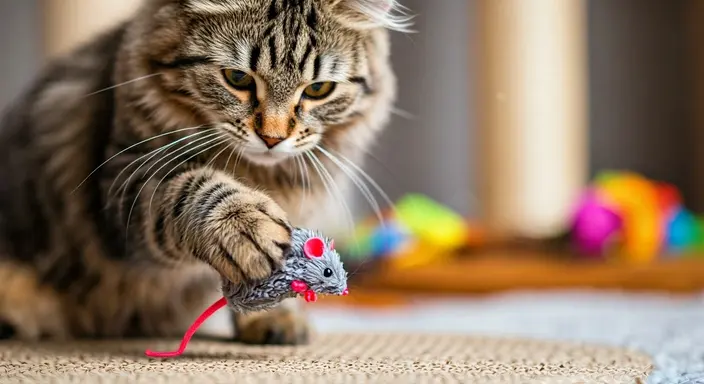When it comes to feline companions, many owners assume that cats are simply “untrainable” creatures of instinct. This misconception couldn’t be further from the truth.
In reality, structured training is one of the most effective ways to nurture a cat’s natural intelligence, curb unwanted behaviors, and foster a harmonious relationship between pet and owner.
Whether you’re a first-time cat parent or a seasoned enthusiast, understanding the principles of cat training can unlock surprising benefits for both you and your furry friend.
Benefits for Cats: Beyond the Basics
Cats thrive on mental engagement and clear boundaries. Without proper stimulation, boredom can lead to destructive habits like scratching furniture or excessive vocalization. Training provides:
- Mental enrichment: Interactive exercises and commands stimulate cognitive development, keeping their minds sharp.
- Behavioral improvement: Consistent guidance reduces anxiety-driven actions, such as aggression or litter box avoidance.
- Physical health: Play-based training (e.g., puzzle toys or agility exercises) encourages movement, combating sedentary lifestyles.
Benefits for Owners: Strengthening the Bond
A well-trained cat isn’t just a joy to live with—it can deepen the trust and communication between you. Consider how training enhances your experience:
- Clearer communication: Teaching cues like “no” or “come” bridges the gap between human expectations and feline instincts.
- Reduced stress: Fewer behavioral issues mean less frustration for you and a calmer environment for your cat.
- Shared confidence: Success in training fosters mutual respect, transforming your dynamic from passive coexistence to active partnership.
Debunking the “Untrainable” Myth
Contrary to popular belief, cats are highly adaptable learners. While they may not respond to commands like dogs, their problem-solving skills and social intelligence make them prime candidates for patient, reward-based training.
Modern techniques emphasize understanding feline psychology—using treats, play, and positive reinforcement to guide behavior.

Why Train Your Cat?
Beyond the “Untrainable” Stereotype
Cats are often dismissed as aloof or unresponsive to guidance, but this myth overlooks their remarkable adaptability.
In reality, felines are highly intelligent creatures capable of learning through patience, positive reinforcement, and understanding of their instincts.
Training isn’t about bending a cat’s will—it’s about nurturing their curiosity and problem-solving skills in ways that align with their innate behaviors.
Studies show that structured interaction can even boost a cat’s confidence, encouraging them to explore their environment more freely.
Mental and Physical Health: More Than Just Playtime
Training isn’t just about tricks; it’s a cornerstone of holistic feline wellness.
Regular mental engagement through commands, puzzle toys, or agility exercises keeps their minds sharp and prevents boredom-driven destruction, such as scratching furniture or knocking over valuables.
Physically, these activities encourage movement, combating sedentary lifestyles linked to obesity and related health risks.
Even simple routines, like teaching a cat to “high-five” or navigate an obstacle course, can provide the stimulation they crave.
Tackling Behavioral Challenges Head-On
Scratching surfaces, inappropriate elimination, or aggression often stem from unmet needs, not defiance.
Training offers solutions by redirecting these behaviors constructively. For example, teaching a cat to associate a scratching post with rewards can replace furniture damage with a healthier habit.
Similarly, crate training provides a safe space for anxious cats, reducing stress during travel or vet visits while giving owners peace of mind.
By addressing root causes rather than punishing symptoms, training fosters trust and long-term harmony.
Emotional Rewards: Building Trust and Confidence
A well-trained cat isn’t just obedient—they’re emotionally secure. Techniques like clicker training, which pairs a distinct sound with treats, help cats overcome fears and develop resilience.
This method has been shown to strengthen bonds between pets and owners, transforming relationships from transactional coexistence to mutual understanding.
Owners, in turn, gain confidence in managing their cat’s behavior, reducing frustration and enhancing daily interactions.
Practical Advantages: Safety, Routine, and Connection
Beyond behavior, training equips cats to navigate real-world scenarios safely. Commands like “come” or “stay” can prevent accidents, while leash training allows outdoor exploration without risk.
For multi-cat households, structured routines minimize territorial disputes, creating a calmer household dynamic.
Even minor adjustments—like rotating toys or incorporating short training sessions—can keep environments fresh and engaging, preventing the monotony that leads to stress.
A Path to Mutual Fulfillment
Training isn’t a luxury; it’s an investment in your cat’s well-being and your shared happiness.
By dispelling outdated notions of feline independence, we open doors to deeper connections, healthier lifestyles, and a home where both cats and humans thrive together.

Understanding Cat Behavior
The Link Between Behavior and Training
At the heart of successful cat behavior training lies a simple truth: cats thrive on positive associations.
Unlike dogs, which often seek to please humans, felines learn through rewards that align with their instincts—think treats for cooperation, toys for play-driven achievements, or safe spaces for comfort.
This reward-based system taps into their natural curiosity, encouraging repetition of desired behaviors while building trust.
Key Insight: Punishment rarely works with cats. It triggers fear or confusion, damaging trust and stifling learning.
Instead, redirect unwanted actions toward acceptable alternatives and celebrate progress, no matter how small.
Decoding Common Behaviors: What Your Cat Is Trying to Say
Understanding how cats learn begins with interpreting their actions. Here’s a breakdown of typical behaviors and their hidden meanings:
- Meowing: While occasional vocalization is normal, persistent meowing might signal hunger, loneliness, or discomfort. Context matters—a cat pacing near their food bowl likely communicates hunger, while meowing at the door could indicate a desire to explore.
- Scratching: Far from mischief, scratching marks territory visually and scent-wise, maintains claw health, and stretches muscles. Providing vertical and horizontal scratching surfaces satisfies these needs.
- Purring: Often a sign of contentment, but cats may also purr to self-soothe during pain or stress. Pair this sound with body language cues—relaxed posture vs. flattened ears—to gauge intent .
- Hiding: Cats retreat when overwhelmed, scared, or unwell. A sudden increase in hiding could signal health issues or environmental stressors, like a new pet in the home.
By observing patterns—such as when and how often a behavior occurs—you’ll gain insights into your cat’s motivations, making training adjustments more effective.
Patience and Consistency: Cornerstones of Success
Cats aren’t stubborn; they’re creatures of rhythm. Their learning process requires time, repetition, and a predictable environment.
For instance, teaching a cat to respond to their name might take weeks of short, upbeat sessions paired with treats.
Consistency in tone, cues, and timing ensures they connect actions to outcomes.
Consider this:
- Timing is critical. Reinforce behaviors immediately—delayed rewards confuse cats, breaking the link between action and consequence.
- Short sessions work best. Five-minute training bursts twice daily align with their attention spans and prevent overstimulation.
- Respect individuality. Shy cats may need quieter settings, while energetic kittens thrive on playful challenges.
Putting It Into Practice
Every interaction with your cat is a chance to shape behavior. If your cat jumps on counters, avoid scolding—instead, place a treat on the floor and praise them for landing there.
Over time, this teaches that staying off counters leads to rewards. Similarly, if your cat avoids the litter box, assess its location (quiet, accessible) and cleanliness before assuming defiance.
By blending empathy with strategy, you’ll not only address behaviors but also unlock your cat’s potential to learn, adapt, and flourish.

Basic Cat Training Techniques
Training a cat isn’t about dominance—it’s about partnership. By leveraging their instincts and rewarding progress, you can shape behaviors that enrich their lives and yours.
Below, we explore three foundational methods: positive reinforcement, clicker training for cats, and integrating play into learning.
Each approach emphasizes respect, consistency, and science-backed strategies to foster a confident, well-adjusted feline companion.
Positive Reinforcement: The Power of Rewards
Cats thrive when they associate actions with pleasurable outcomes. Positive reinforcement cat training focuses on rewarding desired behaviors immediately, whether through treats, affection, or interactive play.
For instance, if your cat uses a scratching post instead of the couch, a quick treat and enthusiastic praise reinforce that choice as a “win.” Over time, this builds a cycle of trust and motivation.
Key Tips for Success:
- Timing is everything: Deliver rewards within seconds of the desired behavior to cement the connection.
- Keep it small and frequent: Use bite-sized treats to avoid overfeeding and maintain engagement during short sessions.
- Tailor rewards to your cat: Some prefer chicken bits, others adore feather wand games—experiment to discover what drives your cat’s enthusiasm.
Avoid punishing mistakes. Cats don’t link punishment to past actions, which can create fear and hinder progress.
Instead, redirect unwanted behaviors to alternatives (e.g., offering a toy when they pounce on your hand).
Clicker Training for Cats: Precision Meets Clarity
Clicker training is a subset of positive reinforcement that uses a handheld device to mark exact moments of success.
The distinct “click” sound acts as a bridge between the behavior and the reward, clarifying what your cat did right. For example:
- Charge the clicker: Pair the sound with treats repeatedly until your cat associates the click with something positive.
- Mark and reward: When your cat sits on command, click immediately, then offer a treat.
- Shape behaviors: Break complex tasks (like walking on a leash) into small steps, rewarding each milestone .
This method is particularly effective for teaching tricks or addressing specific issues, like crate training for vet visits.
The clicker’s precision cuts through ambiguity, making learning faster and more enjoyable for cats.
Playtime as Training: Engage Their Instincts
Cats are born hunters, and play taps into their innate drive to stalk, chase, and pounce. Use toys and games to reinforce training goals while keeping sessions lively:
- Feather wands or laser pointers: Encourage agility and focus by guiding your cat through obstacle courses or target zones.
- Puzzle feeders: Hide treats in interactive toys to stimulate problem-solving skills, mimicking the thrill of foraging.
- Fetch games: Teach retrieval commands like “drop it” using small, lightweight objects your cat enjoys.
Play-based training also strengthens your bond. A study found that cats trained with play showed increased confidence and reduced stress compared to those subjected to passive methods.
Consistency: The Glue That Holds It All Together
Cats flourish with routine. Whether using a clicker or tossing a ball, consistency in cues, rewards, and timing ensures they grasp expectations.
For example, always say “up” when guiding your cat onto a designated perch, and reward them every time until the behavior becomes second nature.
Pro Tip: Short, frequent sessions (5–10 minutes, 2–3 times daily) prevent fatigue and keep your cat eager to learn.
By blending rewards, clarity, and play, you’ll transform training from a chore into a joyful ritual.
Training Cats at Different Life Stages
Cats evolve dramatically throughout their lives, from curious kittens to seasoned seniors.
Effective cat training for kittens, adult cat training, and senior cat training requires adapting methods to match their developmental needs, physical abilities, and cognitive capacities.
By aligning strategies with these stages, owners can foster confidence, address challenges, and maintain mental sharpness across the lifespan.
Kittens: Building Foundations in the Early Weeks
The kitten stage (0–6 months) is a critical window for shaping lifelong behavior.
During this time, kittens are hyper-observant and eager to explore, making it ideal for cat training for kittens focused on socialization and foundational skills.
Key Focus Areas:
- Socialization: Expose kittens to diverse environments, people, and sounds to reduce fearfulness. Pair new experiences with treats to create positive associations .
- Litter Box Training: Use a low-entry box in a quiet area, and reward immediate successes. If accidents occur, avoid punishment—gently relocate the kitten to the box .
- Basic Commands: Teach “come” or “no” using high-value treats like shredded chicken. Keep sessions under five minutes to match their short attention spans.
Pro Tip: Use interactive toys to mimic hunting instincts, such as feather wands to practice stalking or puzzle feeders to stimulate problem-solving.
Adult Cats: Refining Habits and Introducing New Skills
Adult cats (3–10 years) often have entrenched behaviors, but they remain adaptable with patience and consistency.
Adult cat training works best when addressing specific issues or enriching routines to prevent boredom.
Strategies for Success:
- Redirect Undesired Behaviors: If a cat scratches furniture, replace the behavior with a scratching post placed nearby. Reward use of the post with treats or playtime.
- Leash Training: Introduce a harness gradually, allowing the cat to wear it indoors before attaching a leash. Pair with treats to ease stress.
- Advanced Tricks: Use clicker training to teach complex behaviors like “high-five” or navigating an agility course. Break tasks into small steps, rewarding each milestone.
Consistency Is Key: Adult cats thrive on routine. Train at the same time daily and use identical cues (e.g., always say “off” when deterring counter-jumping).
Senior Cats: Gentle Adaptations for Aging Felines
Senior cats (10+ years) may face mobility issues or cognitive decline, requiring senior cat training that prioritizes comfort and mental engagement.
While learning slows, older cats still benefit from stimulation tailored to their needs.
Approaches for Older Cats:
- Low-Impact Enrichment: Replace high-energy games with scent-based puzzles or food-dispensing toys to keep minds active without strain.
- Shorter Sessions: Limit training to 2–3 minutes to prevent fatigue. Focus on simple tasks, like responding to their name, reinforced with soft treats or affection .
- Health Considerations: Adjust methods for arthritis or vision loss—use tactile cues (e.g., gently tapping a paw) instead of visual signals.
Emotional Bonding: Senior cats may resist change, so emphasize trust-building exercises, like gentle brushing or quiet cuddle time, to reinforce security.
Why Age-Specific Training Matters
Each life stage demands a unique approach, but the rewards are universal: reduced stress, stronger bonds, and a cat that feels understood.
Whether you’re guiding a kitten through their first commands, reshaping habits in an adult, or nurturing dignity in a senior, training remains a lifelong journey of connection and growth.

Specific Cat Training Goals
Training your cat isn’t just about teaching tricks—it’s about solving everyday problems and building a harmonious relationship.
Whether you’re guiding a kitten to reliable litter habits or curbing destructive scratching, targeted strategies can transform frustration into success.
Below, we break down actionable steps for four key objectives, backed by science and expert insights.
Mastering Litter Box Training
How to train a cat to use a litter box starts with understanding their instincts. Cats prefer clean, quiet spaces with easy access. Follow these steps to set your feline up for success:
For Kittens:
- Choose the right box: Opt for a low-entry model in a low-traffic area. Place it away from food and water bowls .
- Establish routine: Carry your kitten to the box after meals, naps, and play sessions. Reward immediate successes with treats or praise.
- Troubleshoot accidents: If your kitten eliminates elsewhere, gently relocate them to the box. Avoid punishment—instead, experiment with litter type or box placement.
For Adult Cats Avoiding the Box:
- Rule out medical issues: Sudden avoidance often signals pain or discomfort. Consult a vet if the problem persists.
- Enhance appeal: Add a second box in a new location, switch to unscented litter, or try a covered model. Scoop daily to maintain freshness .
Leash Training
Cat leash training opens doors to safe exploration while satisfying curiosity. Patience and positive associations are key:
- Introduce the harness indoors: Let your cat sniff and nibble the gear, rewarding curiosity with treats. Gradually fasten it for short periods, pairing with playtime or meals.
- Attach the leash: Once comfortable, clip on the leash and let your cat drag it around under supervision. Guide them with treats or toys to prevent tugging.
- First steps outside: Start in a secure, quiet space. Allow your cat to set the pace—forward movement should be rewarded with treats, while pauses or retreats are respected.
Pro Tip: Use a front-clip harness to minimize escape risks. Short, frequent sessions (5–10 minutes) build confidence without overwhelming your cat.
Teaching Cat Tricks: Mental Stimulation Through Fun
Teaching cat tricks isn’t just entertaining—it’s a brain-boosting workout. Start with basics, then graduate to advanced moves:
Foundational Commands:
- Sit: Hold a treat above your cat’s head, moving it backward until they sit. Click or say “yes!” as they lower, then reward.
- Come: Use a distinct cue (e.g., “here!”) paired with treats. Practice in short bursts, gradually increasing distance.
Fun Tricks for Enthusiasts:
- High Five: Gently tap your cat’s paw while saying the cue. When they lift it, reward them immediately. Progress to lifting the paw slightly higher over time.
- Fetch: Use feather toys or crinkly balls. Reward your cat for picking up the item, then gradually add tossing and retrieving.
Key Insight: Break tricks into micro-steps. Cats learn faster when rewarded for incremental progress rather than expecting perfection upfront.
Practical Solutions for Common Issues
Addressing problems like scratching or biting requires empathy and strategy. Here’s how to redirect unwanted actions:
Stop Cat Scratching Furniture:
- Offer alternatives: Place sturdy scratching posts near targeted furniture. Experiment with materials (cardboard, sisal) to match preferences.
- Make furniture less appealing: Use double-sided tape or deterrent sprays. Reward your cat for using the post with treats or play .
Biting and Scratching:
- Identify triggers: Overstimulation, fear, or territorial disputes often drive aggression. Watch for tail flicks or flattened ears as warning signs.
- Redirect energy: Replace hands with toys during play. If bitten, freeze movement—sudden withdrawal may escalate the behavior.
Excessive Meowing:
- Address underlying causes: Hunger, loneliness, or medical issues may drive vocalization. Rule out health problems first .
- Train silence: Ignore meowing, then reward quiet moments with attention. Pair a cue like “quiet” with treats to reinforce calm behavior.
Tailoring Techniques to Your Cat’s Personality
Every cat learns at their own pace. Whether you’re troubleshooting litter box habits or mastering leash skills, consistency and positivity are non-negotiable.
By aligning methods with your cat’s unique temperament and needs, you’ll turn training into a rewarding ritual that strengthens your bond, one small victory at a time.
Common Mistakes to Avoid
Even the most well-intentioned cat owners can stumble into habits that derail progress.
Avoiding these missteps not only preserves your sanity but also ensures your cat feels safe and motivated to learn.
Below, we explore critical errors to sidestep, rooted in science and expert insights.
Punishment Often Backfires: Why Force Fails
Cats don’t process discipline the way humans or dogs might. Swatting, yelling, or physically correcting a cat often breeds fear, mistrust, or redirected aggression.
For instance, scolding a kitten for scratching furniture may simply teach them to avoid you when they’re curious, not to stop scratching altogether.
Instead, redirect unwanted actions to appropriate alternatives (e.g., a scratching post) and reward successes. Positive reinforcement builds confidence, while punishment creates a cycle of anxiety.
Pro Tip: If your cat’s behavior concerns you, consult a vet or certified trainer—aggression or litter box avoidance could signal underlying stress or medical issues.
Inconsistent Routines: Confusing Your Cat
Cats thrive on predictability. Training sporadically or using mixed signals (e.g., allowing counter-surfing one day and scolding the next) muddles the message.
For example, if you inconsistently reward “come” commands, your cat may ignore the cue entirely, unsure if compliance leads to treats or indifference.
How to Fix It:
- Train daily: Even 5-minute sessions reinforce consistency.
- Use identical cues: Pair verbal commands (e.g., “up”) with gestures to avoid confusion.
- Involve all household members: Ensure everyone follows the same rules to prevent mixed messages.
Unrealistic Expectations: Patience Is Non-Negotiable
Impatience sabotages progress. Assuming your cat should master “sit” in a day or hold a leash walk for 30 minutes sets both of you up for frustration.
Kittens, for instance, have attention spans of mere seconds, while senior cats may need extra time to adapt to new habits.
Realistic Benchmarks:
- Kittens: Focus on one short lesson per day; complex tricks may take weeks.
- Adults: Address one behavior at a time (e.g., leash training vs. crate comfort).
- Seniors: Prioritize low-impact goals, like responding to their name, rather than agility drills.
Key Insight: Celebrate small wins. A single successful “high five” or a litter box victory is progress worth reinforcing.
Other Costly Errors to Sidestep
- Ignoring body language: Flattened ears or a flicking tail signal stress—pause training to let your cat decompress.
- Overfeeding treats: Use tiny rewards to avoid overindulgence; reserve high-value snacks for breakthrough moments.
- Using your hands as toys: Encouraging biting during playtime teaches aggressive habits—opt for feather wands or balls instead.
Stay Positive, Stay Consistent
Training isn’t about perfection; it’s about persistence and empathy. By avoiding punitive tactics, embracing routine, and aligning goals with your cat’s natural rhythms, you’ll foster a partnership built on trust.
Advanced Cat Training and Fun Tricks
Once your cat masters the basics, the world of advanced cat training opens up—a realm where mental stimulation meets creativity.
Beyond “sit” and “stay,” felines can thrive in agility challenges, perform clever tricks, and even explore roles that support humans.
Cat Agility Training
Agility courses aren’t just for dogs. With patience and the right setup, cats can navigate tunnels, weave poles, and low jumps, channeling their inner hunter. Here’s how to start:
- Design a course: Use cardboard boxes for tunnels, low hurdles (e.g., broomsticks on books), and platforms for jumping. Keep obstacles lightweight and safe.
- Introduce elements gradually: Lure your cat through each obstacle with treats or toys. Celebrate small successes—like a single jump—before adding complexity.
- Maintain short sessions: Five minutes is often enough to keep your cat engaged without overwhelming them. End on a positive note to leave them eager for more.
Pro Tip: Use a consistent cue, like “up” for jumps, paired with a clicker to mark precise moments of success.
Teaching Complex Tricks
Advanced tricks challenge your cat’s problem-solving skills and deepen your bond. Start with these crowd-pleasers:
Fetch:
- Choose a lightweight, crinkly toy your cat enjoys.
- Toss it a short distance and reward them for picking it up.
- Gradually add retrieval by gently guiding them back to you with a treat.
Jumping Through Hoops:
- Hold a hoop at floor level and lure your cat through with a treat. Raise the hoop incrementally as they gain confidence.
- Pair the action with a cue like “through” to create a verbal association.
Spin in a Circle:
- Hold a treat near your cat’s nose, then slowly move it in a circular arc. Reward them when they follow the motion.
- Fade the lure and use only the hand signal or verbal cue.
Key Insight: Break tricks into micro-steps. For example, teach “weave” by starting with two poles spaced far apart, then gradually reduce the distance .
Training for Therapy or Service Roles
While rare, some cats excel in roles that bring comfort or assistance. Though not as common as dogs, therapy cats provide emotional support in hospitals or nursing homes, leveraging their calm demeanor.
Others learn tasks like retrieving medications or alerting to medical changes—a niche but growing field in advanced cat training.
Considerations for Success:
- Focus on breeds or individuals with naturally gentle temperaments, like Ragdolls or Persians.
- Prioritize socialization and obedience before introducing task-specific cues.
Why Advanced Training Matters
Engaging your cat’s mind prevents boredom-driven destruction and strengthens trust.
Whether navigating an agility course or mastering a high-five, these activities tap into their instincts while fostering a sense of accomplishment.
Plus, the joy of watching your cat solve a puzzle or execute a trick is unmatched—a testament to their intelligence and your shared dedication.
Conclusion: Embracing the Journey of Cat Training
Training your cat isn’t just about correcting behaviors—it’s about unlocking their potential, deepening your bond, and creating a harmonious life together.
Throughout this guide, we’ve explored how structured interaction can transform your feline friend’s mental and physical well-being, reduce stress, and even address issues like scratching or litter box avoidance.
By leveraging techniques like positive reinforcement, clicker training, and play-based learning, you’re not only teaching commands but nurturing a confident, well-adjusted companion .
The Power of Patience and Consistency
Success in feline education hinges on two principles: patience and routine.
Cats thrive on predictable, short sessions that respect their natural rhythms. Whether you’re guiding a kitten through their first litter box lesson or refining agility skills in an adult, consistency builds trust and clarity.
Remember, progress isn’t always linear—celebrate small victories, like a single successful “come” command or a scratch post replacing furniture. Over time, these moments compound into lasting change.
Your Cat’s Potential Awaits
Every cat, regardless of age or personality, can learn and grow.
By embracing training as a lifelong partnership, you’re not only shaping behaviors—you’re enriching your shared world with mutual respect and joy.
So start small, stay positive, and watch as your feline companion surprises you with their intelligence and adaptability. The journey of feline development is as rewarding for you as it is for them.
In the end, training isn’t about control—it’s about connection. And in that connection, both you and your cat will thrive.




